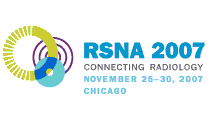
Abstract Archives of the RSNA, 2007
SSC09-06
Total Liver Volume CT Perfusion Using 3D Image Fusion to Improve Detection and Characterization of Focal Liver Lesions
Scientific Papers
Presented on November 26, 2007
Presented as part of SSC09: Gastrointestinal (CT/MR Perfusion: Liver)
Martijn Ruben Meijerink MD, Presenter: Nothing to Disclose
Jan Hein van Waesberghe MD, PhD, Abstract Co-Author: Nothing to Disclose
Lineke van der Weide BS, Abstract Co-Author: Nothing to Disclose
Petroushka van den Tol MD, Abstract Co-Author: Nothing to Disclose
Sybren Meijer MD, PhD, Abstract Co-Author: Nothing to Disclose
Cornelis van Kuijk MD, PhD, Abstract Co-Author: Nothing to Disclose
To evaluate the feasibility of a new “total liver volume” perfusion CT (CTP) technique using 3D image fusion for the detection and characterization of liver metastasis.
Eighteen patients suitable for resection and/or radiofrequency ablation of liver metastasis received a liver CT before and 11-times after rapid intravenous injection of contrast material. At first, only the conventional 4-phases (unenhanced, arterial, portal venous and equilibrium) were evaluated, scoring all visible lesions as appearing either malignant or benign. Hereafter, all series were registered to the portal venous phase series and arterial and portal venous blood flow maps were created. Subsequently, all 12-phases including these blood flow maps were evaluated, again scoring all visible lesions as appearing either malignant or benign. For both techniques, lesion based sensitivity and specificity for the detection of liver metastases was determined as compared to the gold standard of intraoperative ultrasound and surgical exploration. Arterial and portal venous liver tissue perfusion was calculated both for normal appearing liver tissue and for liver metastases.
Compared to conventional 4-phase CT, total volume CTP increased sensitivity from 74.2% to 87.1% and specificity from 76.2% to 81.0%. Perfusion values were comparable to studies using “single level” CTP.
Total volume liver CTP is a non-invasive, quantitative and feasible technique, which can easily be implemented in routine pre-operative and follow-up examinations of patients with liver metastases.
Preliminary results suggest an improved detection of liver metastases for total volume CTP compared to conventional 4-phase CT.
Meijerink, M,
van Waesberghe, J,
van der Weide, L,
van den Tol, P,
Meijer, S,
van Kuijk, C,
Total Liver Volume CT Perfusion Using 3D Image Fusion to Improve Detection and Characterization of Focal Liver Lesions. Radiological Society of North America 2007 Scientific Assembly and Annual Meeting, November 25 - November 30, 2007 ,Chicago IL.
http://archive.rsna.org/2007/5008212.html

